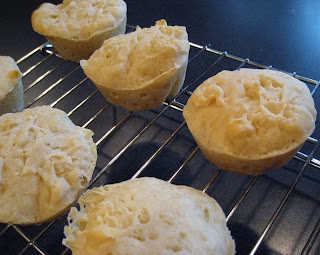Okay, I know what you're thinking - this doesn't sound like it has anything to do with quilting (well, maybe you're not thinking this, but something totally different, but I'm not going to go in that direction!), but it really does, just bear with me.
A few days ago I was at a friend's house and she was making cloverleaf rolls. The buns were in muffin pans set out to rise on her stove. They looked gorgeous: smooth and round and all puffed-up. Now, although I like to bake, I don't usually make buns, but I do have a bread maker which will do most of the hard work for me, so I thought why not give it a try. I was especially encouraged when I read her blog post, which included luscious pictures of her buns (no comments, please!) and her recipe. So, although it was beastly hot out, I decided to make cloverleaf rolls.
All started out well. I put all of the ingredients in the bread maker and then went out to run some errands. When I returned the dough cycle was done and the dough was puffed up to the top of the bread maker. I took out the dough and, as per Cathy's instructions, put three small dough balls in each muffin tin compartment and put them out to rise again. Which they didn't. So, I covered them with plastic wrap, set a damp towel on top of them and put them out in the sun to rise. Which they did, but... when I took off the plastic wrap, they fell again. Rats! I put them in the oven anyway, cooked them using convection (it was hot, remember?) and they did bake up okay, but were quite dense, not the light, fluffy buns that I was hoping for. I think they'll be great for breakfast biscuits with egg, cheese and bacon (which I never eat, but just saying).
 |
| First attempt at buns Not light and fluffy at all |
 |
| Second attempt at buns Dough is looking good |
 |
| Dough ball out of bread maker Perfect! |
 |
| Buns ready to go into the oven |
 |
| Light and fluffy sort-of-cloverleaf roll |
 |
| Baked bread - yum! |
So, don't be discouraged if your buns or quilts don't turn out the way you'd hoped for the first time, just find another recipe or method and try again. I'm certain that you'll be rewarded with fluffy, golden buns - or quilts!
By the way, Cathy's buns were more rounded than mine - she obviously has this bun baking thing down cold, er hot :)








